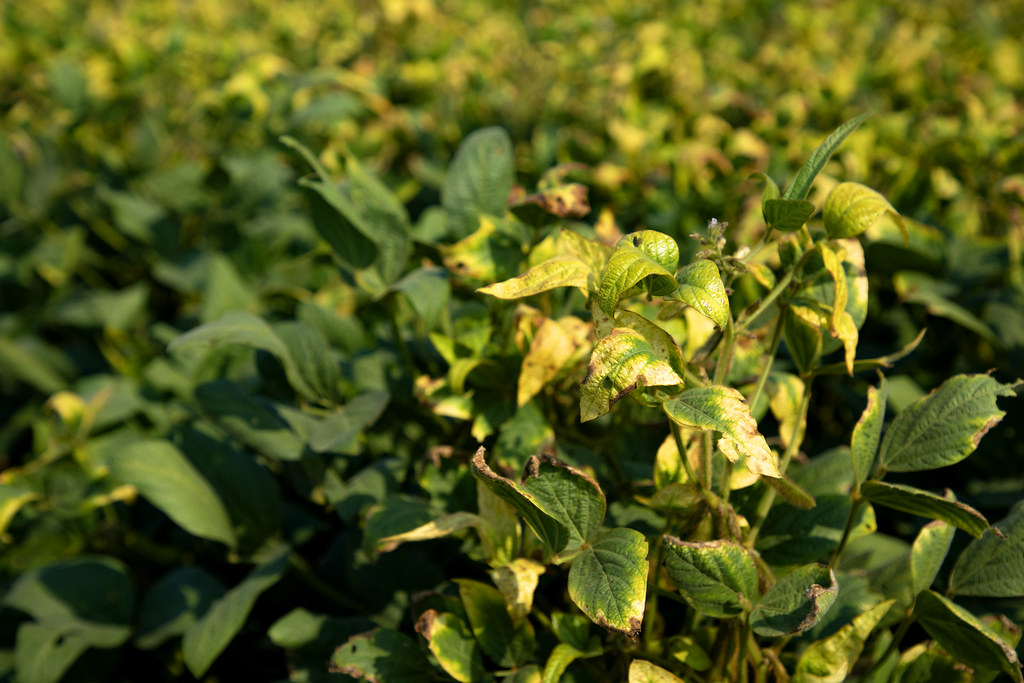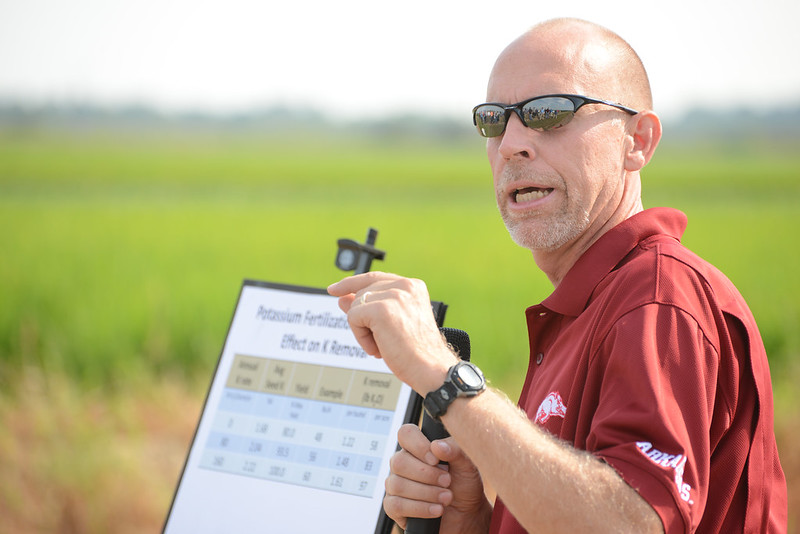Managing Potassium and Maximizing Profitability in Arkansas Soybeans

The Problem
Soybean is one of Arkansas’ largest commodities. In 2018, 3.24 million acres of soybean were harvested. With about three million acres of soybean planted every year, Arkansas soybean producers need tools to maximize the production potential and profitability of their crops.
Potassium deficiency is the primary limitation affecting soybean profitability. Producers must carefully manage potassium levels in their soil by knowing when, where and how much fertilizer to apply. Soybean yield and profitability suffer when potassium levels are too low, but producers have few tools to guide potassium management decisions. Current potassium fertilizer recommendations are based solely on soil test results, which may not provide the precision required to maximize profitability. To date, there has been little data to support in-season correction of potential potassium deficiencies.
Arkansas soybean producers need better and more targeted tools to help make informed decisions about potassium fertilizer inputs.
The Work
Over a period of about 20 years, soil fertility researchers with the Arkansas Agricultural Experiment Station conducted a series of experimental trials to evaluate the response of soybean to potassium fertilizer rates. This data was correlated and calibrated with soil test data, allowing researchers to make more targeted estimates about when and where potassium deficiency might occur. Where potassium deficiency occurs, there is a risk of limiting soybean yield. With the help of agricultural economist Mike Popp, the data from these trials were used to develop a tool that producers can use to estimate profit-maximizing potassium fertilizer application rates based on producer input data.
More recently, the soil fertility team began looking at soybean tissue potassium concentrations over a series of growth stages. Previous research has shown that tissue potassium concentration decreases as soybean crops continue to grow. Thus, the timing of sample collection is crucial to interpreting tissue potassium concentrations. This work resulted in the development of dynamic critical potassium concentration thresholds.
Using dynamic critical potassium concentration thresholds allowed researchers to use soybean tissue potassium levels to evaluate in-season soybean crops for “hidden hunger” or to corroborate visual potassium deficiency symptoms. Hidden hunger is a condition that describes soybean plants that are experiencing a yield-robbing nutrient deficiency, but otherwise, look healthy. These thresholds can help producers decide when in-season potassium applications may be profitable and ensure that potassium is not limiting yield.

The Results
The two tools developed as a result of these experiments — the profit-maximizing potassium rate estimation tool and the dynamic critical tissue potassium concentration thresholds — can help producers maximize soybean yield potential and profitability. Producers can use this information to closely monitor the potassium status of the soil in their fields and the tissue concentration of a growing soybean crop. These two pieces of vital information will help ensure that potassium is not limiting production potential or profitability.
These tools are in the process of being distributed to the public online and through the cooperative extension service. As they are incorporated into traditional crop scouting and crop management practices, producers will have more tools to prevent potassium deficiency from limiting soybean yield and profitability.
The Value
The profit-maximizing potassium rate estimation tool can provide a data-based potassium fertilizer rate that balances fertilizer and application costs with yield potential, existing potassium concentrations in the soil and soybean prices. At typical soybean prices and input costs, producers can potentially increase profits by over $100 per acre compared to applying no fertilizer, depending on field-specific parameters. This tool can also help producers determine when applying fertilizer may hurt their profits.
By using the dynamic critical tissue potassium concentration thresholds, producers could see a net return of about $25 per acre for a field suffering from hidden hunger and about $75 per acre for a field suffering from extreme potassium deficiency, assuming typical soybean prices and potassium fertilizer and application costs.
As Arkansas producers plant approximately three million acres of soybean each year, every dollar increase in profit per acre can result in significant economic value.
Funding
Arkansas Soybean Promotion Board
Fertilizer Tonnage Fees
University of Arkansas System Division of Agriculture
About the Researcher

Trent Roberts
- Associate professor of soil fertility and soil testing.
- B.S. in plant science from Oklahoma State University, M.S. in soil science from the University of Arizona and Ph.D. in soil science from the University of Arkansas.
- Conducts research in soil fertility and plant nutrition, with an emphasis on developing new soil test and plant analytical methods. Roberts investigates crop response to soil nutrients like nitrogen and potassium and hopes to develop better management strategies for crop production.

Nathan Slaton
- Associate vice president for agriculture and assistant director of the Arkansas Agricultural Experiment Station, Interim head of the department of crop, soil and environmental sciences.
- B.S. in agronomy from Murray State University, M.S. and Ph.D. in agronomy from the University of Arkansas.
- Research interests include correlation and calibration of soil‐test and plant‐analysis based fertilizer recommendations; evaluation of fertilization methods, sources, and times for crop production; development of critical plant nutrient concentrations for monitoring plant nutrient status; and evaluation of enhanced efficiency fertilizers for rice production.

Michael Popp
- Professor of agricultural economics and agribusiness
- Bachelor of Commerce in management information systems, University of Manitoba, Canada; MBA in Finance, University of Colorado; Ph.D. in Agricultural and Resource Economics, Colorado State University
- Research interests include farm and agribusiness management with emphasis on alternative production practices and related implications for returns, risk and environment; best management practices for both row-crop and livestock production; analysis of the feasibility of alternative fuels; risk/return tradeoffs associated with enterprise diversification of farm operations and analysis of partial life cycle assessments on greenhouse gases and water footprint.

